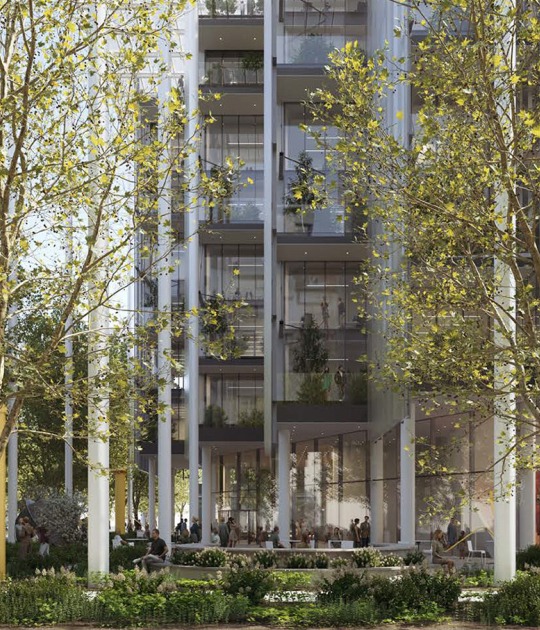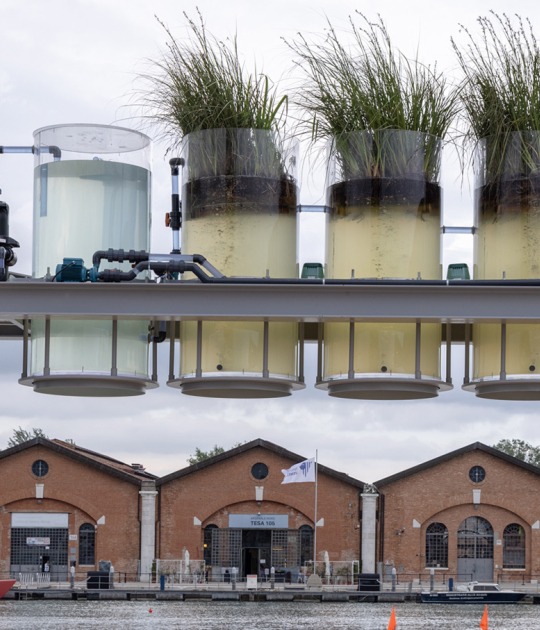Presented by the Royal Australian Institute of Architects (RAIA), Repair as an approach to architectural thinking, that is, how architecture can play a role in repairing the places of which it is a part, will become a critical strategy of the architectural culture. It is particularly relevant for Australian architects who work in one of the most diverse and ecologically sensitive landscapes in the world, where the pre-settlement condition can still be known and understood.
Creative Directors Mauro Baracco and Louise Wright of Baracco + Wright Architects, in collaboration with artist Linda Tegg, have curated a multi-sensory living installation for the Pavilion, designed to disrupt the viewing conditions through which architecture is usually understood.
The curators will install ten thousand plants inside and outside of the Pavilion, including 65 species of Western Plains Grasslands. This component of the exhibition, entitled Grasslands Repair, will serve as a reminder of what is at stake when we occupy land – just one per cent of these threatened species are left in their native ecosystem. The Pavilion will be transformed into a field of vegetation, allowing visitors to enter a physical dialogue between architecture and the endangered plant community.
Alongside this, Linda Tegg and Baracco + Wright Architects have made an experimental video series, entitled Ground, showcasing fifteen Australian projects that unpack diverse iterations of repair, which will be projected inside the Pavilion. A third installation, Skylight, will incorporate lighting to simulate the sun’s energy required to sustain the plants inside the Pavilion. Through each of these works, the curators aim to provoke a rethinking of how we value and therefore create the built environment.
Addressing the theme of Freespace set by curators Yvonne Farrell and Shelley McNamara for the Biennale Architettura 2018, Repair will address the call ‘to stimulate discussion on core architectural values’ and validate the ‘relevance of architecture on this dynamic planet’. It will focus on architecture that integrates built and natural systems to effect repair of the environment, and in so doing, mend or improve other societal, economic and cultural conditions. Through this lens, this exhibition will provoke new relevance and roles for architecture.
Australia’s buildings and cityscapes have largely been constructed to separate people from the natural environment. Consequences of this disregard are now being felt, resulting in a shift in thinking amongst built environment disciplines, towards repairing the natural environment as a framework for urban form. Repair aims to advocate a role for architecture among the many players it takes to restore something.
Curators Mauro Baracco and Louise Wright said:
Creative Directors Mauro Baracco and Louise Wright of Baracco + Wright Architects, in collaboration with artist Linda Tegg, have curated a multi-sensory living installation for the Pavilion, designed to disrupt the viewing conditions through which architecture is usually understood.
The curators will install ten thousand plants inside and outside of the Pavilion, including 65 species of Western Plains Grasslands. This component of the exhibition, entitled Grasslands Repair, will serve as a reminder of what is at stake when we occupy land – just one per cent of these threatened species are left in their native ecosystem. The Pavilion will be transformed into a field of vegetation, allowing visitors to enter a physical dialogue between architecture and the endangered plant community.
Alongside this, Linda Tegg and Baracco + Wright Architects have made an experimental video series, entitled Ground, showcasing fifteen Australian projects that unpack diverse iterations of repair, which will be projected inside the Pavilion. A third installation, Skylight, will incorporate lighting to simulate the sun’s energy required to sustain the plants inside the Pavilion. Through each of these works, the curators aim to provoke a rethinking of how we value and therefore create the built environment.
Addressing the theme of Freespace set by curators Yvonne Farrell and Shelley McNamara for the Biennale Architettura 2018, Repair will address the call ‘to stimulate discussion on core architectural values’ and validate the ‘relevance of architecture on this dynamic planet’. It will focus on architecture that integrates built and natural systems to effect repair of the environment, and in so doing, mend or improve other societal, economic and cultural conditions. Through this lens, this exhibition will provoke new relevance and roles for architecture.
Australia’s buildings and cityscapes have largely been constructed to separate people from the natural environment. Consequences of this disregard are now being felt, resulting in a shift in thinking amongst built environment disciplines, towards repairing the natural environment as a framework for urban form. Repair aims to advocate a role for architecture among the many players it takes to restore something.
Curators Mauro Baracco and Louise Wright said:
“We have often struggled with our relationship as architects when considering the use of land – it’s no small act. We believe there is a role for architecture to actively engage with the repair of the places it is part of, which our exhibition will communicate. We hope the discussion we’re presenting will engage the profession and initiate a legacy of the Biennale Architettura 2018.”
Jill Garner, Chair of the Royal Australian Institute of Architects, International Architecture Exhibition of La Biennale di Venezia Committee, said:
“The RAIA is honoured to take part in this year’s Biennale Architettura, the most important event in the international architectural calendar. Repair will offer an immersive, multi-sensory experience that will captivate visitors. The exhibition represents an approach to architectural thinking that we believe will become a critical strategy of architectural culture worldwide.”
The curators invited a team of local experts to reflect on architecture from unconventional positions so that the theme could be more deeply explored. The wider team supporting the creative directors includes architect and anthropologist Paul Memmott, landscape architect Chris Sawyer, landscape architect and urban designer Tim O’Loan, ecologist David Freudenberger, curatorial advisor Catherine Murphy, architects Lance van Maanen and Jonathan Ware.
Through the team’s expertise in architecture, landscape architecture, urban design, ecology, indigenous culture and conceptual thinking, a diverse filter can be applied to the gaps, possibilities and issues facing Australian architects who work in one of the most diverse and ecologically and culturally sensitive landscapes in the world, to create architecture not yet fully imagined.
Repair will be the seventh exhibition coordinated by the Royal Australian Institute of Architects at the Biennale Architettura. The exhibition will be installed in the Denton Corker Marshall-designed Pavilion of Australia (2015) – the first 21st-century Pavilion to be built in the Giardini.





























![Friedrich Kiesler, Endless House for Mary Sisler [shattered sketch sheet], New York and Florida, 1961, 21.5 x 33.4 cm, pencil on paper, mounted on cardboard. Courtesy by the Austrian Frederick and Lillian Kiesler Private Foundation, Vienna Friedrich Kiesler, Endless House for Mary Sisler [shattered sketch sheet], New York and Florida, 1961, 21.5 x 33.4 cm, pencil on paper, mounted on cardboard. Courtesy by the Austrian Frederick and Lillian Kiesler Private Foundation, Vienna](/sites/default/files/styles/mopis_home_news_category_slider_desktop/public/2025-05/metalocus_Fundacio%CC%81n-Frederick-Kiesler_03_p.jpg?h=3b4e7bc7&itok=kogQISVW)












